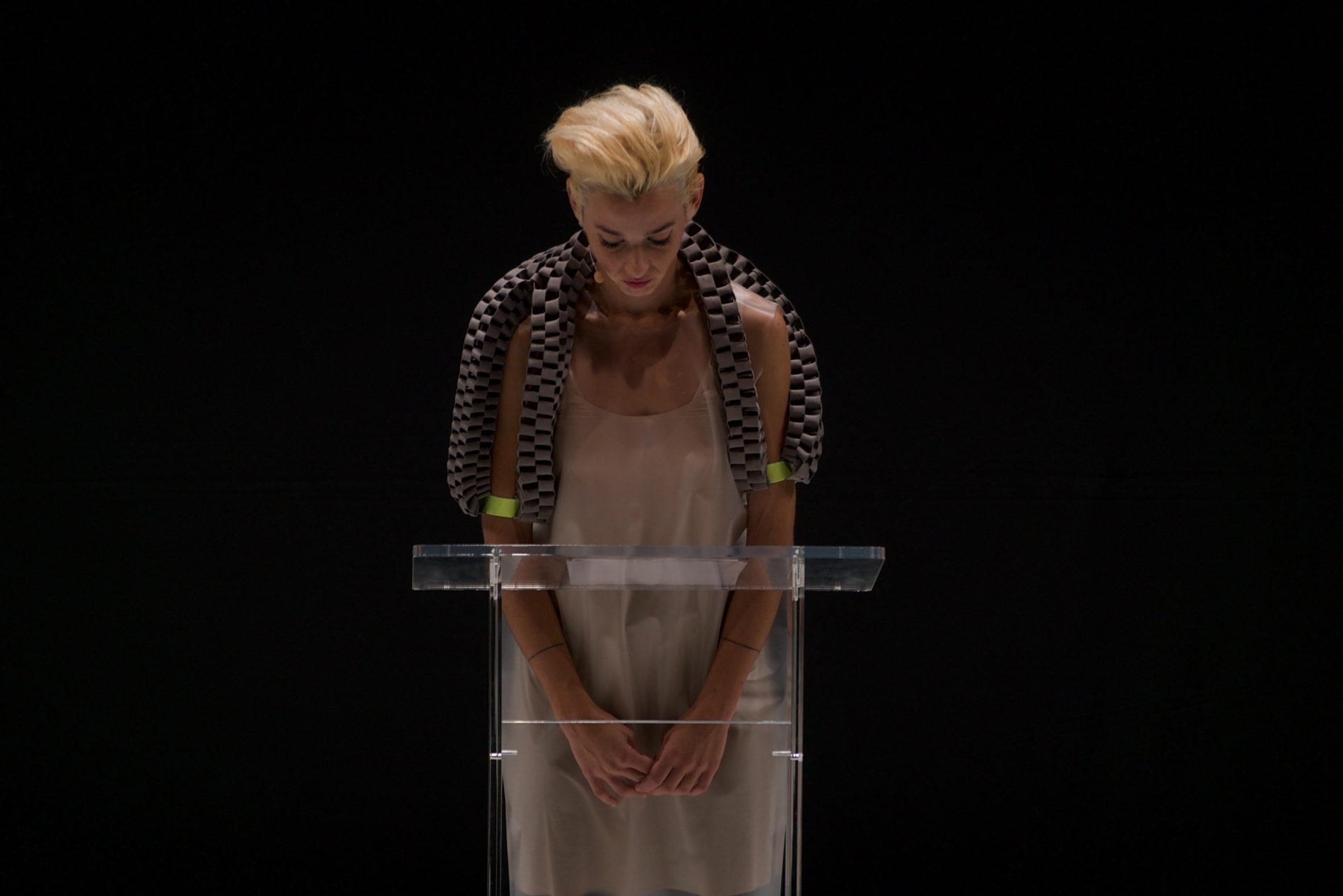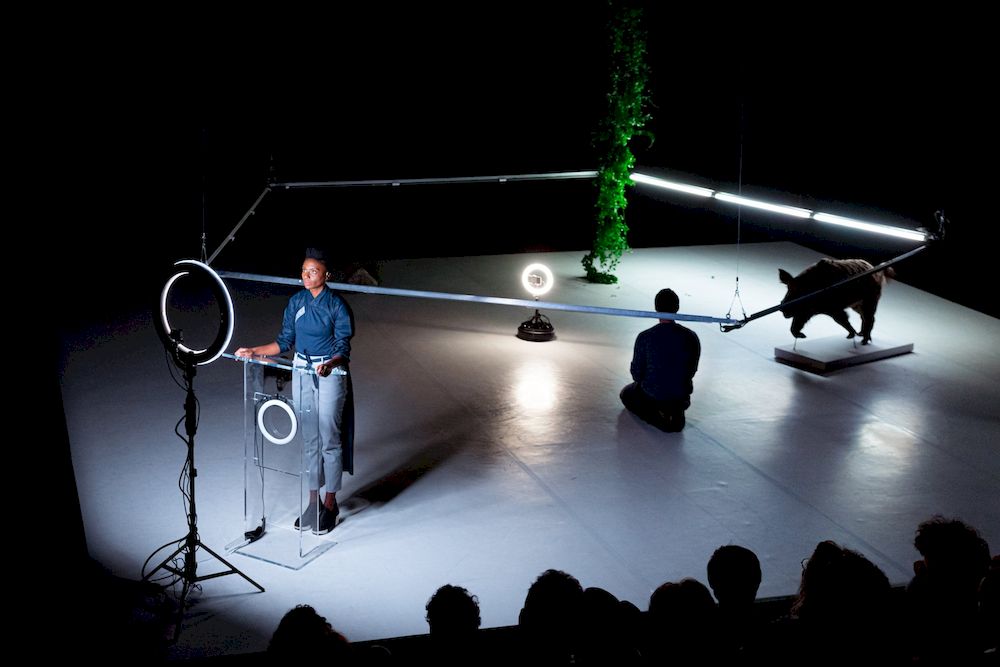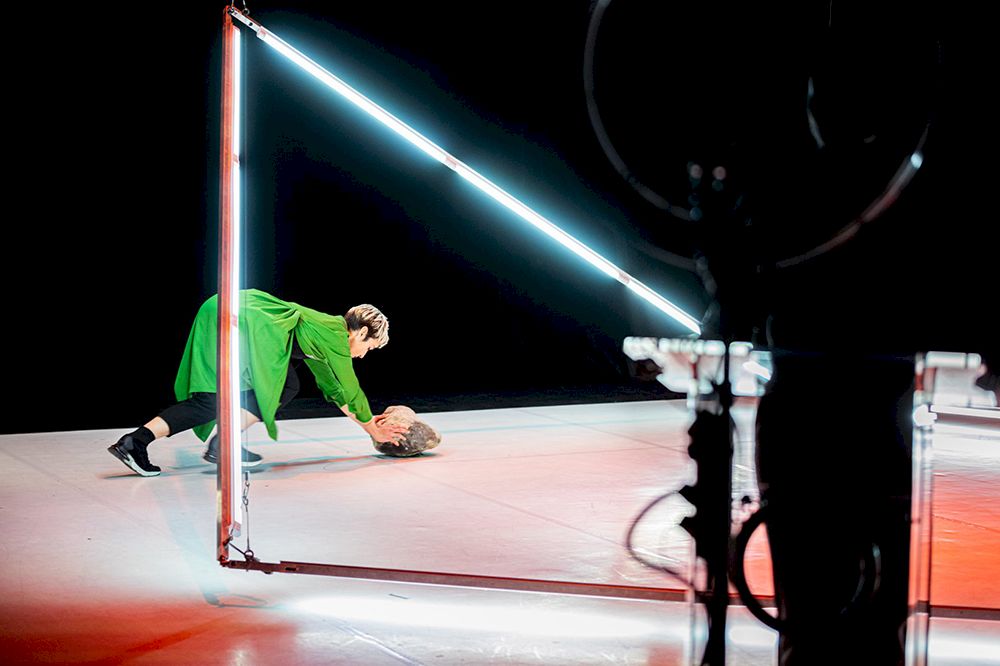Rocio Berenguer: “Dethrone humans from the summit of their pyramid”
Published 14 October 2020 by Maxence Grugier
Transdisciplinary artist Rocio Berenguer was in residence at Théâtre Nouvelle Génération in Lyon, France, from September 21 to October 9, 2020. Makery met her on site.
Actress, stage director and choreographer, hypermedia artist Rocio Berenguer bases her research and the works of her theater company Pulso on staging the body in relation to new technologies, ecology and scientific research. During her exploratory residency at Théâtre Nouvelle Génération in Lyon, she developed The Bad Weeds, a real/fake music band made up of bad weeds, hybrids from the plant kingdom who have come to share their message with humans. The Bad Weeds is a spin-off of her famous G5, a performance with philosophical and political roots that is inspired by (and mocks) the G20—by reuniting representatives of the different kingdoms that coexist, for better or for worse, on our planet: mineral, plant, animal, human and… machine!

Makery: What was the genesis of G5/Coexistence? Sitting in your apartment in the ultra urban environment of central Paris, what inspired you to explore relationships between species, with the natural environment, etc.?
Rocio Berenguer: G5 is a project in three parts: a performance (Coexistence, 2019), a theater/dance piece (G5, 2020) and an installation (Lithosys, 2020). In the beginning there was Animal and Homéostasis. For Homéostasis I imagined a dialogue between an artificial intelligence—a chatbot that I named Animal—and a human. Animal was an entity, something that comes to life, a fictional being that for me had a life of its own. In the performance, Animal interacts with me, a human. This came out of approaches to human-machine interactions that I had initiated in IAgotchi. In parallel, I also wanted to work with the imaginary “machine kingdom”. Among our “kingdoms” (animal, plant, mineral, etc.), I imagined the arrival of a new element: machines. Everything spun out of these speculations on the different kingdoms of contemporary life and the relationship that I had with Animal as a fictional entity.
Makery: So you were leaning toward certain science-fiction themes connecting us to machines?
R.B.: Yes, but I especially wanted to explore the way that we see and live with machines today, their symbolic relationship with humans. What kind of representations we inject into this relationship and what parallels we can draw between these relationships and the relationships we have with other living things. I was especially interested in the way we project affection and emotion on our machines.
At the time, I was reading The Posthuman by the Italian philosopher Rosi Braidotti, who is close to Donna Haraway, whose The Companion Species Manifesto I had also read. Braidotti and Haraway really opened my mind to certain ideas and an original approach to our relationships with living things and machines. I was especially fascinated by Braidotti’s proposals for concrete actions, hybridization, etc.
From all these sources emerged a project that was first called Regnum Machina, a wordplay on the academic aspect of Latin, which led me to question the way we classify life into “kingdoms”. What exactly is this term that evokes a hypothetical king’s domain? Finally I decided to summon all these life forms, both organic and symbolic, to negotiate the future of life on Earth. I’m concerned about issues related to the environment, Anthropocene, collapsology. I’ve been a vegetarian for a long time, I have a very strong relationship with living things and all other forms of life besides humans. It was important for me to talk about all this in my work. I thought it was about time to dethrone humans from the summit of their pyramid, put everyone on the same level, rearrange all this and rehabilitate our relationships. This work is all the more important because it challenges our whole relationship with others, otherness, as well as existing hierarchical relationships within the human species.

Makery: This notion of arbitrary hierarchy also turns up in language and communication. We need a universal language. Is this what led to your idea of finding a common language and a translation system, which is at the heart of G5?
R.B.: I met the linguist Célia Hoffsteter in Grenoble. She was interested in gender relationships and hierarchy in language. I focused on issues of submission/domination in the structure of the language—why we choose to use a certain article, a certain pronoun, etc., and how this builds a hierarchical relationship between us and objects, and by extension, those that we consider to be “object” or “subject”. Language poses a lot of questions about the way we organize our hierarchical relationships between living-living and living-inanimate, as well as between different orders of living things.
So when I started writing G5, I realized that it was going to be difficult to create this potential equality that I imagined, as language was so implicitly charged with hierarchical elements (gender, class, value assessment, etc.) that only served humans. I wanted to overcome these obstacles. The problem is that, other than mathematics, there exists no language that is neutral and relational. The expressions that we use to express the type of relationships that we have are very poor. We are “friends”, “collaborators”, etc., but these words remain vague and factual. There is no nuance. We have so many different types of relationships with each other that have yet to be expressed. I felt that we needed to create a language where these relational issues can be created. I had a book on the history of universal languages that indexed the various projects to create global languages, such as Volapuk, Esperanto, Ido, etc. Even if none of these languages was really adopted, it’s a beautiful human desire to create a universal language, a neutral space, which is not part of a process of economic or cultural domination.
Rocio Berenguer, “G5” (excerpts):
Makery: Can you talk about Érodée, this premise of a mineral mythology?
R.B.: In order to build the foundation for G5, I needed to write a new mythology. Lockdown provided the perfect opportunity, when Antoine Conjard from Théâtre de l’Hexagone in Grenoble commissioned a text from me, on a topic that I hold dear: the importance of minerals. This text became Érodée. I don’t know yet what it will become later, but it invents a new history of evolution, in which the mineral is the origin of everything.
For me it’s true, the mineral is the origin of everything. Life originated on a stone, from a primary soup of minerals. In my story, Earth wants to shine as it did before, when it was still a piece of molten rock spinning in space. It also wants to join Venus, the brightest of all the stars. So Earth decides to form outgrowths on its skin that turn toward the sky, eat light and keep growing higher. This is the dawn of the plant kingdom. But Earth hasn’t considered one problem: plants make an atmosphere, which is an extra layer that prevents it from reaching outer space. So Earth creates millions of life forms to eat the plants: representatives of the animal kingdom.
Unfortunately, these animals only think about eating and reproducing, and they forget to look at the sky. So Earth decides to create a different life form, which distinguishes itself from its animality. It’s humans who gaze upward and begin dreaming about going to the stars. But humans are physically incapable of going to outer space by themselves. Outside the planet’s atmosphere, they die. In a last burst of ingenuity, Earth invents a kingdom that uses minerals—cobalt, copper, zinc and silicium—to assist humans in their quest to explore space and join Venus, its lifelong love. This story is already present subliminally in G5. The most troubling element is the mineral. The end of the performance is centered on it. Symbolically, the mineral is both the beginning and the end.
Makery: G5 is presented like a real political summit, a diplomatic meeting among all the kingdoms, both ancient and new. But it’s also a humorous vision of politics, its representation and its rituals.
R.B.: Clearly! Any policy that doesn’t truly take into account the relationship we have with all living things is simply not a policy. At best, it’s a “necropolicy” (I’m borrowing this term from Achille Mbembe, who uses it in a different context, but it fits well here). What kind of policy doesn’t take into account otherness? What policy has no consideration for the context in which humanity appeared, or for its relationships with other species? A policy that does not protect life in its continuity is not worth applying, listening to, or respecting.

Makery: Currently you’re working on The Bad Weeds, a sort of spin-off of G5, based on a key character of the performance. This new project is multidisciplinary: music, dance, theater, freestyle, open…
R.B.: During lockdown, I was alone at home with this “bad weed” costume that appears in G5. So I got the idea of creating something based on it. The Bad Weeds also came about from a long period of very structured work around rather closed performances (even if complex): Homéostasis, Ergonomics and G5/Coexistence. After three years of touring and working with teams, on often demanding structures, I really needed a free space for expressing some of the ideas that I have been carrying forever and that come out in my other works.
Makery: It seems like The Bad Weeds radicalizes often well-meaning attitudes about today’s environmental problems…
R.B.: Current activism around ecology pushes a lot of guilt and a paternalistic aspect that I can’t stand. I wanted to distance myself from all that and offer something more free and optimistic. The Bad Weeds expresses a vital impulse. This union of plant and human that expresses itself, resists and exists, is a hybrid life that inhabits the cracks between the spaces occupied by humans. It’s an illustration of life in the margins. Right now I’m working on it with Haini Wan, an actress, dancer, singer and musician. We did a piece for the research phase, but also a music video, because The Bad Weeds contains everything I want to do: form a band, perform live, make music, wander through festivals. It’s very free.
The Bad Weeds, Resist (2020):
I was very much inspired by Le petit traité du jardin punk by Eric Lenoir. Today, it’s increasingly difficult to engage in rebellion and revolt without going through consumption. We are encouraged to consume fairly, equitably, organically and responsibly, but in the end it’s just about consumption. Most of these ways of engaging have become obsolete, we need to invent other ways. It’s difficult for citizens to get involved beyond these consumer choices. I believe that the most creative and rebellious approaches emerge from the cracks. It’s no longer a question of revolt, but of “how you practically make possible the existence of another world” (following the example of deferred development zones such as Longo Maï where I lived for three months). We need to invent other ways of occupying unused, abandoned lands. The Bad Weeds is a metaphor for this desire to invest in concrete action: a bad weed that did not wait for human manipulations in order to exist, that grows wherever it finds a space. It’s a symbol.
The Bad Weeds Trip at Kepler’s Garden in Linz during Ars Electronica, September 2020:
More information on Rocio Berenguer
